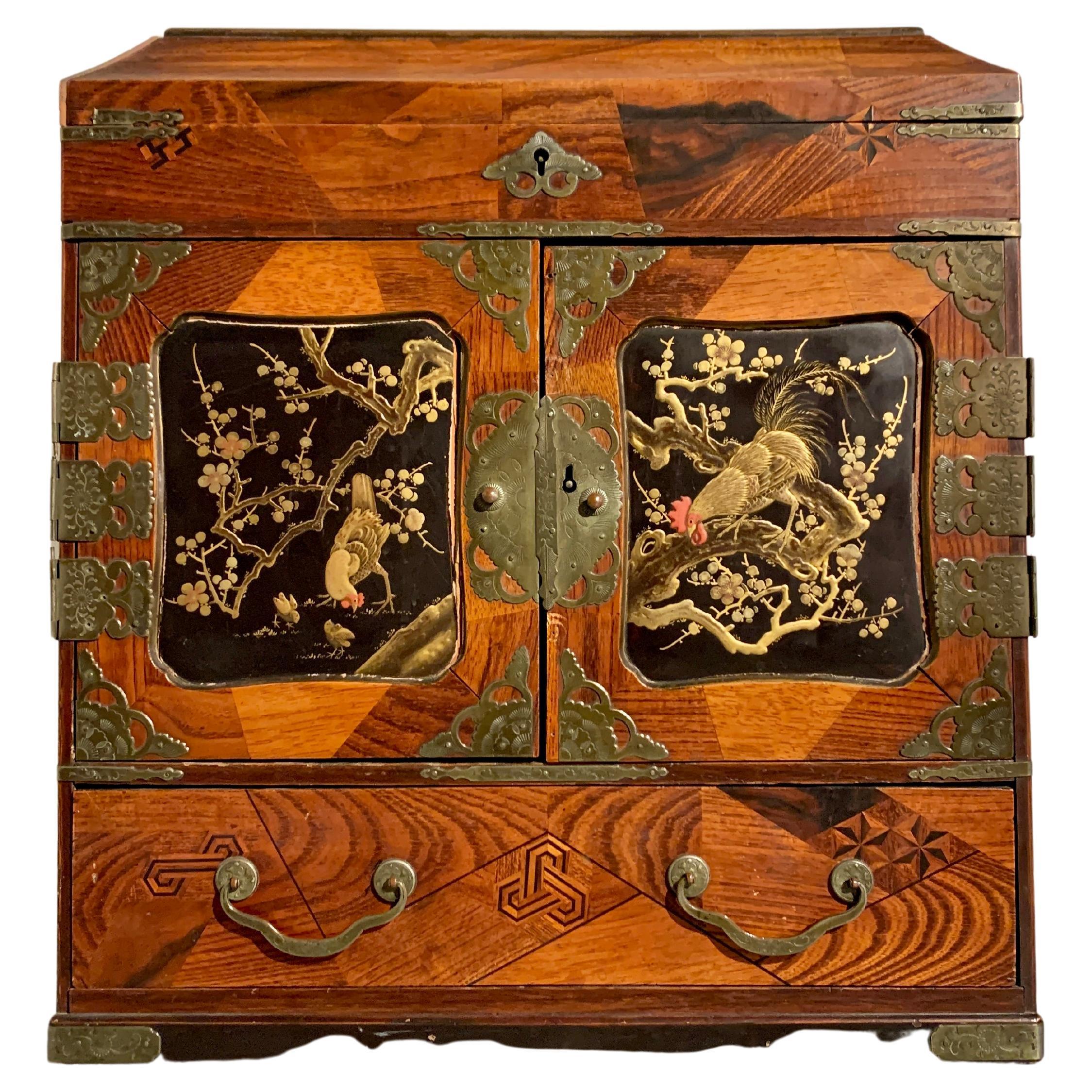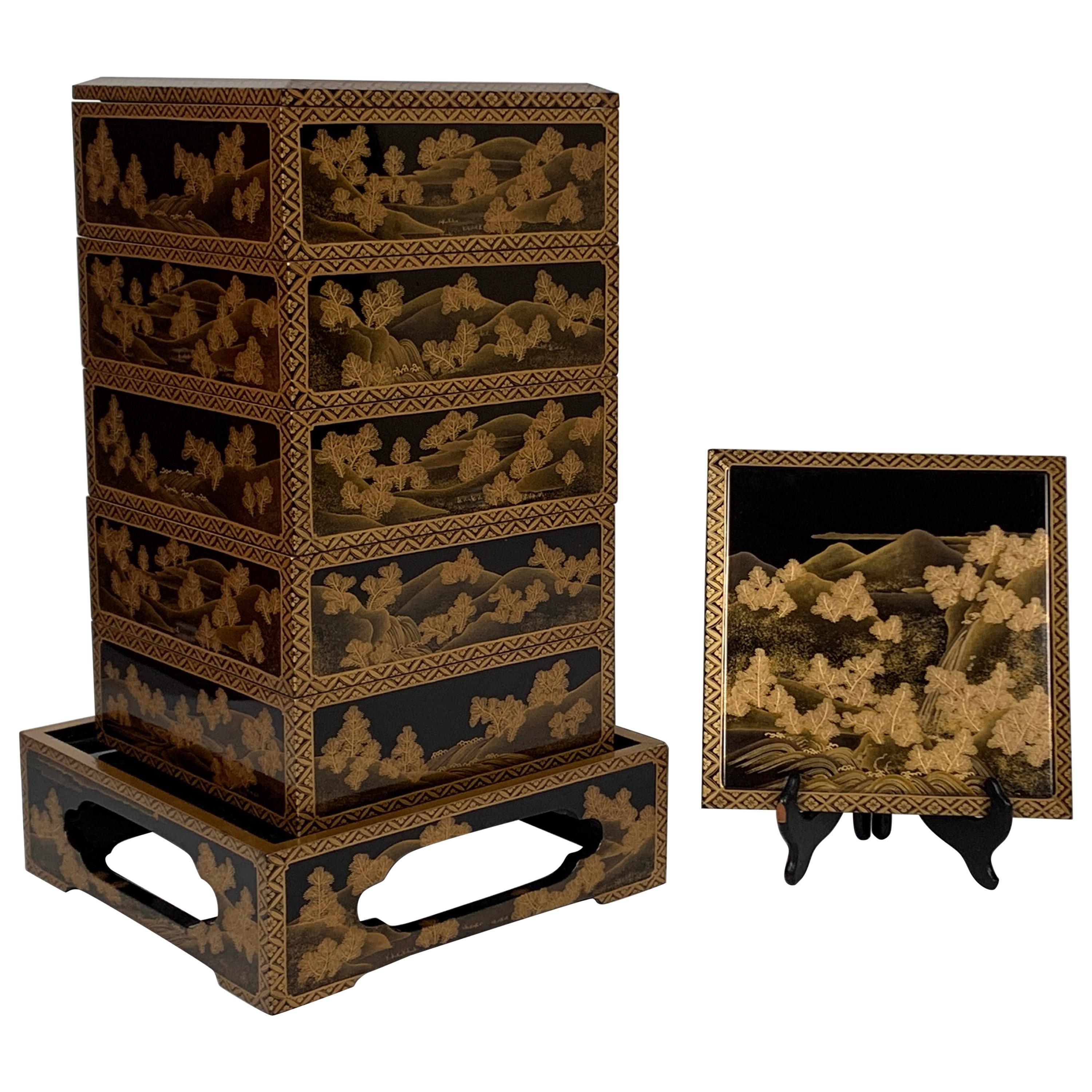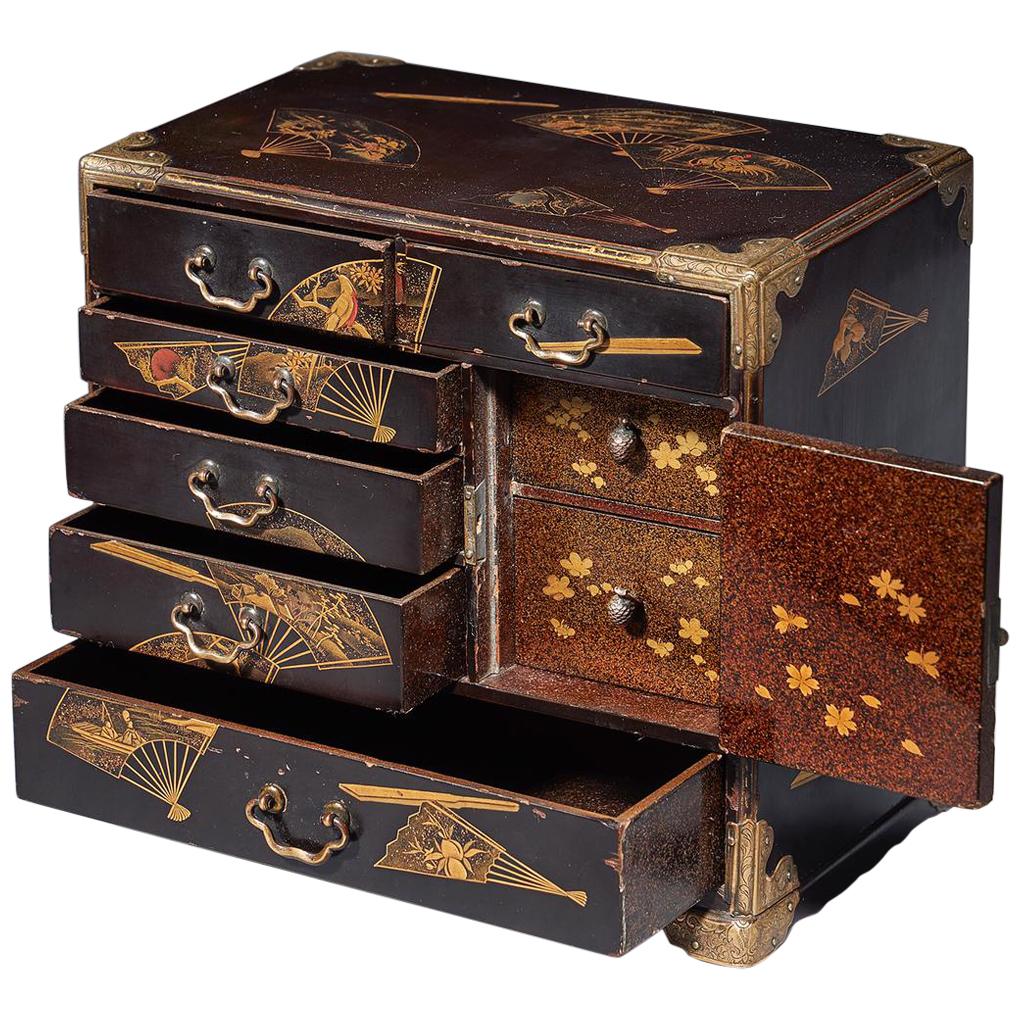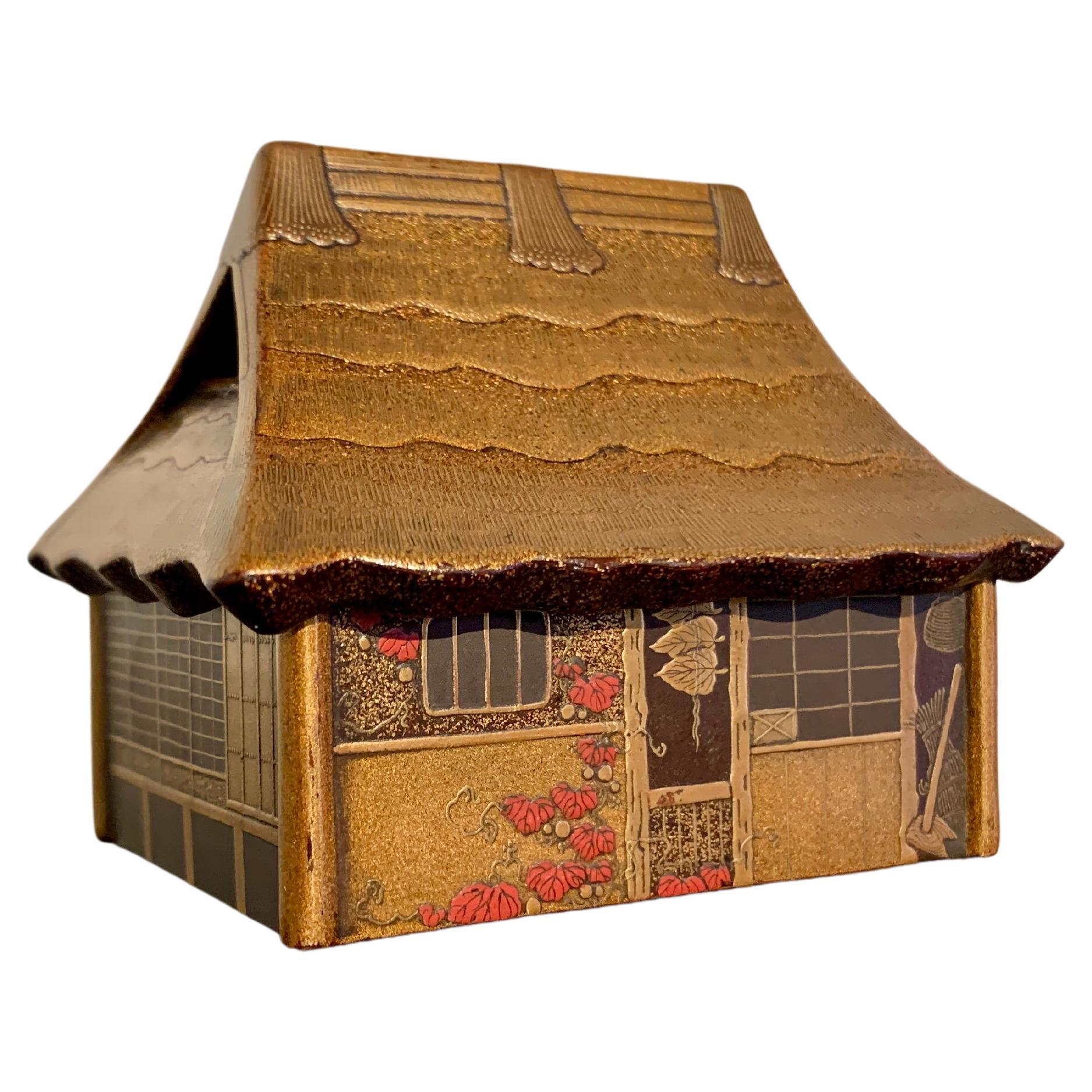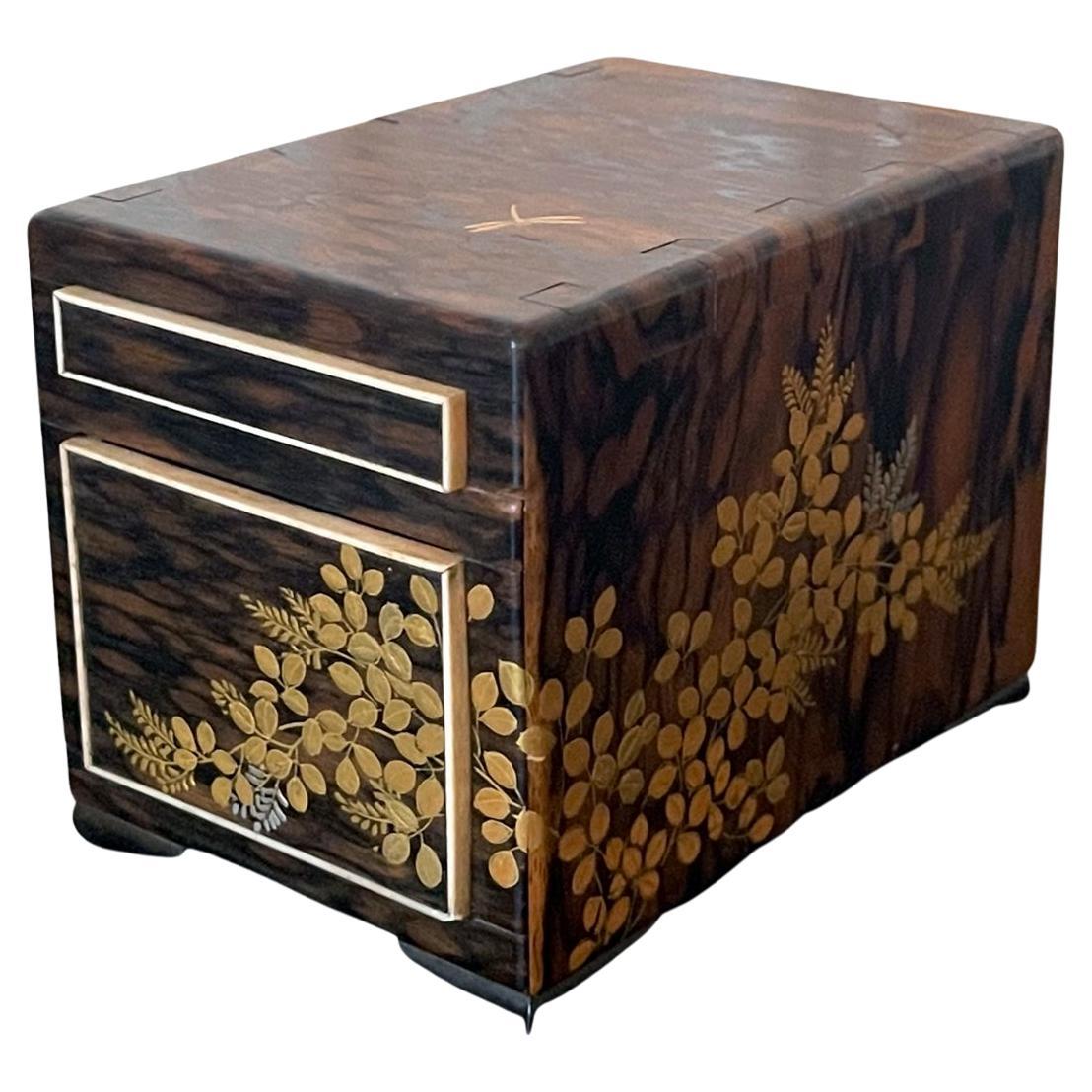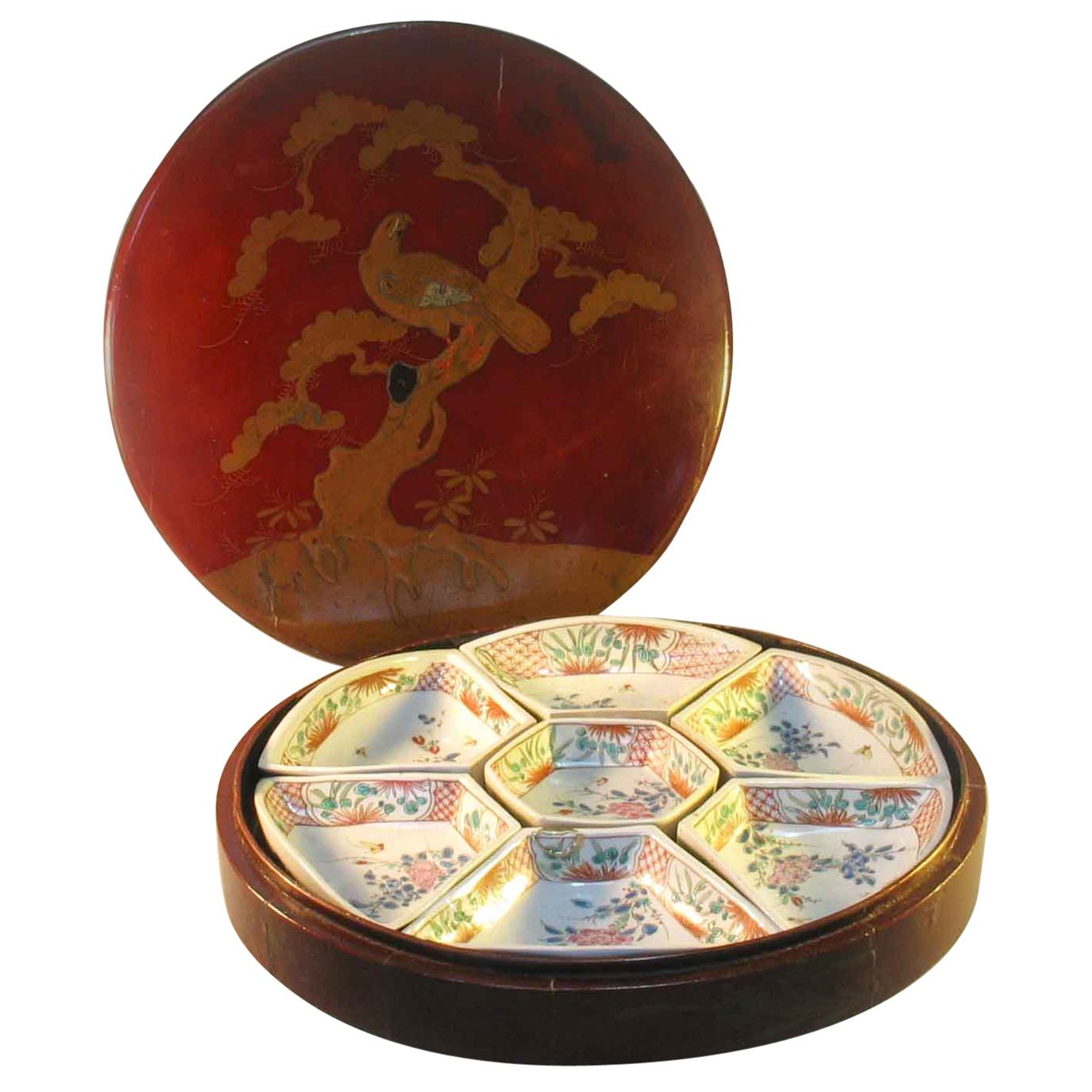Items Similar to Japan 1900 Meiji Miniature Hanagamidai Cabinet in Gilded Wood & Sterling Silver
Want more images or videos?
Request additional images or videos from the seller
1 of 11
Japan 1900 Meiji Miniature Hanagamidai Cabinet in Gilded Wood & Sterling Silver
About the Item
Miniature hanagamidai cabinet from the Japan meiji (1858-1912) period.
Gorgeous and rare miniature drawers hanagamidai (cosmetic cabinet), created in the imperial Japan during the Meiji period, circa 1900. This is a little piece of furniture realized in miniature, composed by a rectangular body with 6 drawers of different sizes and a fixed tray on top. Carefully crafted in ebonized lacquered wood with gilding decorations of flowers in gold hiramaki-e, togidashi-e and nashiji, with joints and garnitures made in solid sterling silver. The construction and assembly is excellent. The joints between the panels were made with masterful care where the sterling silver parts show the areas where they were riveted with the pins.
Weight: 1145 Grams, (733.97 Dwt).
Measurements: 260 mm by 181 mm by 231 mm (10.25 x 7.13 x 9.12 Inches).
Hallmarks: Signed in the bottom with the maker's cartouche inside a circle.
Provenance: Objets D'art Gallery, Kensington, MD.
Condition: The overall condition of this Hanagamidai is very good. Beside the little normal and usual wear, there is no damage to any parts. All silver garnitures are secured in the settings. This piece has been carefully inspected to guarantee the condition and authenticity.
INVENTORY REF: D031223MNNE/.4521.
- Dimensions:Height: 10.25 in (26.04 cm)Width: 9.12 in (23.17 cm)Depth: 7.13 in (18.12 cm)
- Sold As:Set of 7
- Style:Meiji (Of the Period)
- Materials and Techniques:
- Place of Origin:
- Period:1900-1909
- Date of Manufacture:1900
- Condition:Wear consistent with age and use. Minor losses. The overall condition of this Hanagamidai is very good. Beside the little normal and usual wear, there is no damage to any parts. All silver garnitures are secured in the settings. This piece has been carefully inspected to guarantee the condition.
- Seller Location:Miami, FL
- Reference Number:
About the Seller
5.0
Platinum Seller
These expertly vetted sellers are 1stDibs' most experienced sellers and are rated highest by our customers.
1stDibs seller since 2023
63 sales on 1stDibs
Typical response time: <1 hour
- ShippingRetrieving quote...Ships From: Miami, FL
- Return PolicyA return for this item may be initiated within 1 day of delivery.
More From This SellerView All
- Japan 1870 Meiji Period Round Five Drawer Inro Lacquered Wood With Flying CranesLocated in Miami, FLJapanese Inro from the Meiji Period (1868-1912). Beautiful Inro, created in Japan during the Meiji imperial period, circa 1870. It was carefully crafted in carved precious wood with...Category
Antique 1870s Japanese Meiji Lacquer
MaterialsGiltwood, Lacquer, Wood, Ebony
- Japan 1890 Meiji Shibayama Round Urn in Gilded Wood and Sterling SilverLocated in Miami, FLShibayama urm from the Japan meiji (1858-1912) period. Gorgeous piece of art, created in the imperial Japan during the Meiji period, circa 1890. This is a little urn with a lid crafted in gilded wood, shibayama panels and sterling silver. Composed by a four footed round vase with two sterling silver handles in the shape of trees and the lid on top accented with the figure of a crab in sterling silver. The gilded wood is decorated with flowers, sea patterns and the imperial flower...Category
Antique 1890s Japanese Meiji Antiquities
MaterialsMulti-gemstone, Gold, Silver, Sterling Silver, Gold Leaf
- Japan 1800 Edo Period Six Drawer Inro In Lacquered Gilt Wood With UtensilsLocated in Miami, FLJapanese Inro from the Edo Period (1603-1867). Beautiful Inro, created in Japan during the Edo period (Shogunate), circa 1800. It was carefully crafted in carved precious wood with ...Category
Antique Early 1800s Japanese Edo Lacquer
MaterialsCoral
- Japan Meiji 1900 Three Bronze Ducks Sculpture in Wood Stand and CoralLocated in Miami, FLSculptural composition of the ducks from the Japanese Meiji Period. Beautiful and very well realized sculptural composition of three ducks, made during the japanese imperial perio...Category
Antique Early 1900s Japanese Meiji Sculptures and Carvings
MaterialsCoral, Bronze
- Victorian 1900 Clam Shaped Coins Purse Wallet In .900 Sterling SilverLocated in Miami, FLClam Conch Shaped Coins wallet Purse. A beautiful piece, created during the late Victorian era (1837-1901) circa 1900. This is a coins wallet crafted in the shape of a clam conch, i...Category
Antique Early 1900s Spanish Late Victorian Decorative Boxes
MaterialsSilver, Sterling Silver
- Japan 1810 Kajikawa Edo Period Five Drawer Inro Lacquered Gilt Wood With RoosterLocated in Miami, FLJapanese Inro from the Edo period (1615-1868) created by Kajikawa. Beautiful Inro, created in Japan by one of the Kajikawa family during the Edo period (1615-1868), circa 1810. Has been carefully crafted in carved precious wood with applications of gilding maki-e and decorated with Japonism patterns. All dan trays are attached together with a himo cord. The detailed craftsmanship was a true pleasure to behold. Period: Edo period (1615-1868). Shogunate. Approximate Date: 1790-1810 Motif: A family of birds consisting of a cockerel, the hen and three chicks. Drawers: Five. Shape: Rectangular navette. Technique: Carved wood, lacquer and decorated in iroe-hiramaki-e on a gold ground. Ojime: 15mm 20mm, oval carved from natural translucent agate. Netsuke: None Weight: 47.70 Grams. Measurements: Inro is 78 mm by 55 mm by 18 mm (3.07 x 2.17 x 0.71 Inches). Signatures: Kajikawa Saku, in the underside with the signature KAJIKAWA. By a member of the Kajikawa family, signed Kajikawa 梶川 Japan, late 18th century to early 19th century, Edo period (1615-1868). The Kajikawa family Kajikawa family, flourished in the 19th century, they was Japanese lacquerware artists whose school in Edo (now Tokyo) flourished for more than 200 years. This family is perhaps the most famous of all the dynasties of Japanese lacquer artists, and certainly the name most often found on inro. The family is said to have been founded by Hikobei at Edo in the early 17th century, although some claim that the family’s great reputation really stemmed from his son and pupil Kyujiro. In any event, Hikobei worked for the shogunate, as did his successors until well into the 19th century. Kijirō excelled in designing particularly delicate lacquer inrō, portable medicine cases...Category
Antique 1810s Japanese Edo Lacquer
MaterialsAgate, Gold
You May Also Like
- Japanese Marquetry and Lacquer Jewelry Chest, Meiji Period, circa 1900, JapanLocated in Austin, TXA very attractive Japanese wood table top jewelry or collector's chest with marquetry and lacquer decoration, Meiji period, circa 1900, Japan. Previously in the collection of Asbjorn Lunde (1927 - 2017). The chest is crafted in the form of a Chinese seal...Category
Antique Early 1900s Japanese Meiji Lacquer
MaterialsWood, Softwood, Lacquer
- Japanese Maki-e Lacquer Stacking Box, Jubako, Meiji Period, JapanLocated in Austin, TXA fine and impressive Japanese gold maki-e decorated black lacquer five-tier jubako with presentation tray, two lids, and the original tomobako storage box, Meiji period, late 19th c...Category
Antique Late 19th Century Japanese Meiji Lacquer
MaterialsLacquer
- Japanese Meiji Lacquer Casket in the Manner of Akatsuka JitokuLocated in London, by appointment onlyMount Fuji decorates the cupboard door taking centre stage on a background of gold On this casket, a village can be seen in the valley which is most likely the Oshino Village T...Category
Early 20th Century Japanese Meiji Decorative Boxes
MaterialsLacquer
- Japanese Lacquer House Shaped Incense Box, Kogo, Meiji Period, JapanLocated in Austin, TXA delightful and intricately decorated lacquer box for storing incense, kogo, in the form of a traditional farm house, Meiji period (1864 - 1912), late 19th century, Japan. The kogo, or small box for storing incense, takes the whimsical form of a traditional Japanese home, minka, with the removable high, thatched roof serving as the cover for the box. The exterior of the home has been painstakingly decorated in maki-e lacquer against a matte black lacquer ground. Traditional shoji doors, bamboo blinds...Category
Antique Late 19th Century Japanese Meiji Lacquer
MaterialsLacquer
- Fine Miniature Japanese Kodansu with Lacquer InlaysLocated in Atlanta, GAA fine Japanese miniature kodansu constructed from Kaki wood (Persimmon) circa 19th century, late Meiji period. With its expressive exotic wood grains and exposed tenon construction,...Category
Antique Late 19th Century Japanese Meiji Lacquer
MaterialsWood
- Japanese 7-Pcs, Arita Sweetmeat Set & Matching Lacquer Box Meiji Period, 1880sLocated in Ottawa, OntarioA seven-piece Japanese Arita Sweetmeat set and matching lacquer box, Meiji period (1880-1890). Comprising of a central hexagonal dish and six-fan shaped ...Category
Antique Late 19th Century Japanese Meiji Lacquer
MaterialsPorcelain, Lacquer
Recently Viewed
View AllMore Ways To Browse
Lacquer Lacquer Cabinet
Lacquered Cabinet Wood
Lacquer Signed
Wood Used In Japanese Furniture
Lacquered Panel
Lacquered Wood Gilt
Gilt Lacquer Wood
Japan 1900
Lacquered Wood Panel
Rectangular Lacquer
Japanese Wood Sign
Japanese Wood Crafts
Gilded Wood Art
Lacquered Panels Art
Antique Wood Furniture Parts
Wood Cartouche
Meiji Wood
Meiji Wood Furniture
